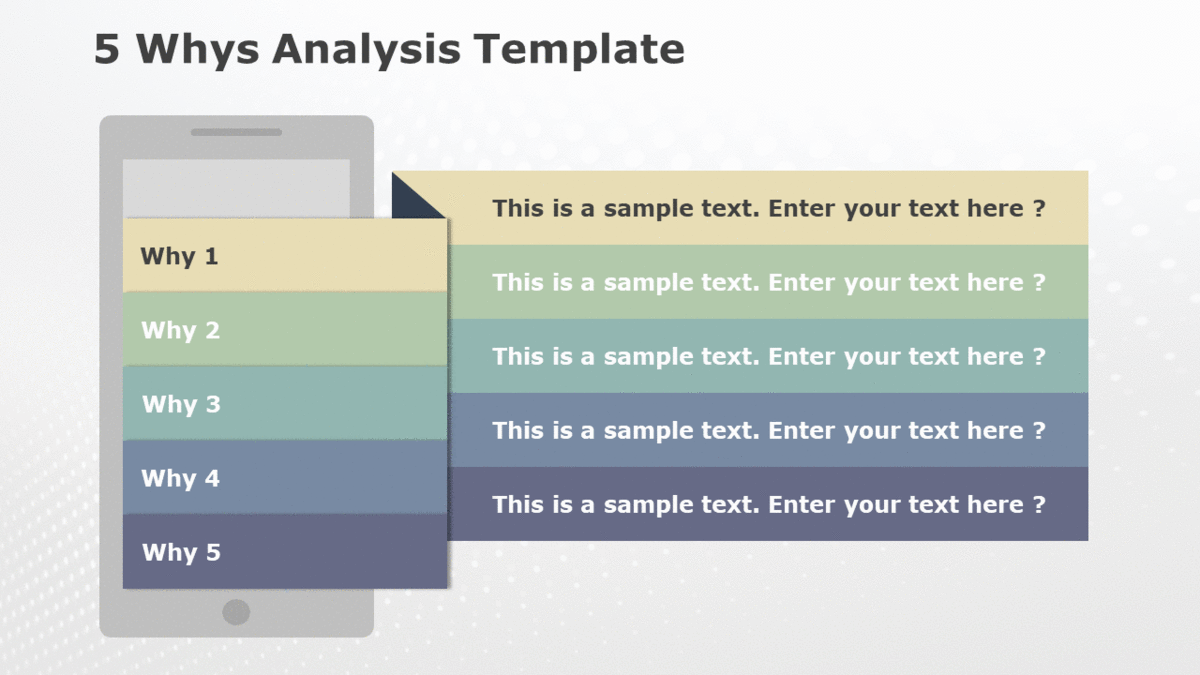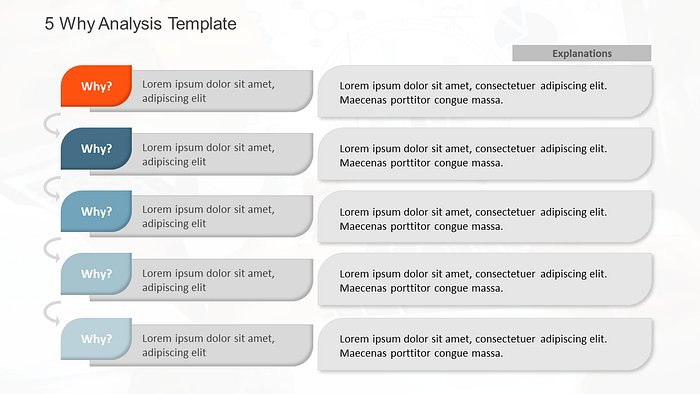Must-Have Tool For Your Root Cause Analysis — 5 Whys (Examples Plus Free Template)

Simon Sinek in his book ‘Power of Why’ and Ricardo Semler with his ‘Three Whys’ approach, both seek to harness the potent potential of asking a simple question ‘WHY?’. They used it to answer pertinent questions related to various spheres of their lives and to arrive at disruptive solutions.
Sakichi Toyoda, the father of the Japanese industrial revolution and the founder of Toyota Industries, introduced the concept of asking a simple question — ‘Why’ to business problem-solving. He developed a managerial problem-solving tool called 5 Why Root Cause Analysis.
In this blog, you’ll read about:
- What is 5 Why Analysis?
- When to use the 5 Why Analysis?
- What are the benefits of 5 Why Analysis?
- How do you conduct the 5 Why Analysis?
- How you can approach problem-solving in a team
- A practical real-life 5 Whys Analysis example
- A few examples of 5 Whys Template
- A few Root Cause Analysis Examples
What is 5 Why Analysis?
The 5 Why Root Cause Analysis is a technique used to analyze any problem by repeatedly asking the question “Why”, which leads to the root cause of a problem. This lends a structured approach to help managers solve business problems. The 5 Why’s is an iterative process used to analyze the cause and effect relationships of a business problem.
Owing to its effective and lean nature, this Root Cause Failure Analysis (RCFA) Tool has gained popularity.
When to use the 5 Why Analysis?
5 Why analysis is a tool commonly employed to determine the role and accountability of human and system processes in the event of a human error. The 5 Why Root Cause Analysis is used to understand the cause and effect of a problem to prevent similar occurrences in the future.
Managers often end up spending time on resolving recurring petty problems. Instead, this time could have been more productively utilized. Adopting band-aid or quick-fix solutions could be a common reason for recurring hiccups. Sometimes, owing to the criticality of the process, managers can’t afford to repeat similar mistakes. In an ideal scenario, a manager would like to address the root cause of the problem and implement a permanent solution.
What are the benefits of 5 Why Root Cause Analysis?
- Helps to understand the nature of an organization’s operational problems
- Helps to devise collaborative solutions
- Helps to determine the root cause faster due to its lean and structured approach
- Doesn’t require special qualifications
- Considers the opinions of all stakeholders
- Follows the Team-oriented problem-solving approach that minimizes the risk of hurting sentiments
How do you conduct the 5 Why Root Cause Analysis?
Here’s the 5 step process that can be used to determine the root cause of recurring business issues in the organization.
Step 1: Form and assemble the team
Team selection is the first essential and critical step of the process. The 5 Whys method suggests involving everyone who is affected by the problem in some manner. Team members should be chosen across shifts, departments or regions. If you are dealing with a shop floor problem, include factory workers alongside your managerial team. It is crucial to make this a team exercise and be open to all perspectives. It is advisable to include a facilitator to steer these meetings.
Step 2: Brief the team
The next step is to brief the team on the purpose of the exercise. The original methodology recommends using a white paper/ whiteboard during this process instead of a computer. Ideally, the facilitator should write down the problem on the whiteboards to ensure the team is collectively aware of it. Allowing cross-discussion will help to formulate a more comprehensive problem statement. Often, defining the problem statement itself is half the solution.
Step 3: Ask ‘Why’s
The facilitator should lead the conversation by asking the first why. He/She should encourage answers based on facts rather than hearsay/ assumptions/emotions. The focus should be on finding the root cause rather than the symptoms or complaints. The process can become a rather lengthy one if the answers are not precise. Sometimes there could be more than one root cause. The root causes should be one word or short phrases rather than lengthy statements.
Step 4: Repeat four times
Each reason listed out in the previous step needs to be reframed into a question. The facilitator should be able to demonstrate the cause-and-effect relationship to the team.
For example, if the cause listed in Step 3 was — ‘Reminder email wasn’t sent to the client’ it would have to be reframed into a question — Why wasn’t the reminder email sent to the client?
Repeat this step four times or until you have determined the root cause.
The 5 Whys technique is an exemplary method of dealing with problems arising from human error. This team problem-solving approach minimizes the risk of hurting sentiments. The team approaches the problem without playing the blame game and searches for the solution together in a constructive manner.
This five Whys method seeks to set in place processes / best practices to avoid the problem rather than assigning blame to a single team member. In other words, the cause needs to be as specific as possible. The team should avoid listing causes as human errors or employee inefficiencies.
Step 5: Arrive at a solution and follow-up
Here’s another reason why the five Whys method is your best bet to arrive at an optimal solution:
- The stakeholders have been represented at the table.
- All that needs to be done is to lead the group to devise a collaborative solution.
Here’s how you can approach problem-solving in a team :
Step 1: Brainstorm:
Defining the problem is half the solution. The facilitator needs to encourage the group to brainstorm for solutions. The facilitator should group ideas based on common lines of thought.
Step 2: Explore:
Each solution needs to be dissected and assessed methodically. The team needs to compare the pros and cons, evaluate the risk involved, perform a cost comparison, and consider the potential risks of implementing the solution.
Step 3: Decide:
The next step is to choose the solution the team plans to implement. The facilitator can then take a consensus on the way ahead. The group needs to detail the process of implementation.
Step 4: Track and Follow up:
Every ‘ smart solution needs to be measurable — whether it is the efficiency of a particular process in terms of percentage or the time-saving attribute of an operation. The setting of milestones ensures that the improvement can be tracked. Sometimes problems tend to evolve. This undesired trait can be kept in check by systematic follow-ups.
A practical real-life business scenario where the Five Why Analysis method is used:
Problem: A renowned advertising agency is facing an acute problem. A client has threatened to pull out on account of the increasing delay in deliverables. The agency calls for a meeting of the responsible managers and executives.
Q1: Why has the client raised the issue of late deliveries?
Ans: There was one instance of late delivery.
Q2: Why was there a delay in this instance?
Ans: The creatives weren’t approved by the Creative Head (CH) as per schedule.
Q3: Why were the creatives not approved within the stipulated period?
Ans: The CH was on sick leave for two days
Q4: Why were the CH’s responsibilities not delegated to a substitute?
Ans: A substitute CH hasn’t been appointed in the organization
Q5: Why hasn’t a substitute CH been appointed?
Ans: We hadn’t predicted the situation and clients are becoming more particular about their deadlines.
Solution: Let’s designate a substitute for the CH and also for some other critical profiles to avoid delays.
How to present the 5 Why Analysis?
After spending considerable time in RCA, you ought to present your Analysis in the most persuasive manner to influence decision-makers. Keeping that in mind, we have designed a collection of 5 Why Templates. The templates’ design ensures the cause and effect analysis is conveyed clearly and succinctly.
Here is a 5 Whys Example-
The below 5 Whys template, can be used to showcase a structured approach towards the root cause of the problem. The question ‘Why’ is asked repeatedly until the most basic answer comes up i.e. the root cause. This framework uses attractive infographic vectors to break the problem into stages to find out the root cause affecting the business.

View 5 Whys Template
A few other examples of 5 Why Templates

View 5 Whys Example

View 5 Whys Root Cause Analysis Template

View 5 Whys Root Cause Analysis Template

View 5 Whys Root Cause Analysis Template

View 5 Whys Root Cause Analysis Template

View 5 Whys Root Cause Analysis Template
The below 5 Whys Template is used to creatively illustrate 5 causes of a business problem in a creative diagram. Using this template, you can state the business issue above the analysis and the conclusion statement at the bottom. This framework helps you acknowledge the possible causes by asking ‘Why’ repeatedly until the root cause is determined.

The below Animated 5 Why Analysis Template performs a ‘5 Why Analysis’ using innovative animation. Using this template, you can identify viable reasons for a business problem by asking 5 ‘Why’ questions. This framework helps you discover the root cause and thus, formulate an effective solution accordingly.

View 5 Whys template
There are other ways of showing the root cause analysis.
Below are a few examples to show the structured way of presenting the potential causes of the problem.

View Root Cause Analysis Template

View Root Cause Analysis Template

View Root Cause Analysis Template
FREE 5 Whys Analysis Template:

View Free 5 Why Analysis Template
This Free 5 Why Analysis PowerPoint uses interactive colours and creative infographics to conduct ‘5 Why Analysis’ effectively. Using this template, you can mention the challenge (or the problem) in the centre and highlight 5 possible reasons for the problem around it. This framework helps you detect the root cause of the problem affecting the business.
To browse more 5 Why Analysis or Root Cause Analysis Templates, visit our 5 Whys library.
Now you don’t have to scour the web to find out the right templates. Download our PowerPoint templates from within PowerPoint. See how?
Conclusion
The ‘5 Why analysis’ is an ideal problem-solving tool that both entrepreneurs and well-established companies can utilize. Using this approach we can find the root cause of a problem and develop corrective or preventive solutions. Its success depends on the ability of the team to delve deep into root causes rather than stop at the symptom level. Having said that, the investigating team should also be open to more than one root cause. Despite criticism, this tool can have a substantial positive effect on your organizational process if performed correctly.
Another way of visualising the root causes of a problem are using Fishbone analysis.


Get more creative ideas to showcase your problem at hand using Problem Solving templates.
About SlideUpLift:
SlideUpLift is an online platform to help professionals make compelling presentations using principles of vision science and storytelling. The platform contains an online library of pre-designed presentation templates that can be used across industries and functions.
Check out our library of free PowerPoint templates & Google Slides Templates which is weekly updated to serve the presentation needs of professionals. You will find out the simplicity and ease in downloading the editable template, filling it with your content, and building world-class presentations in just a few clicks.
Originally published at http://slideuplift.com on January 24, 2020.
